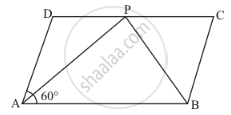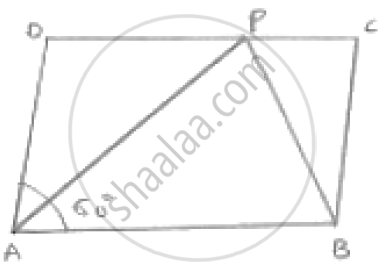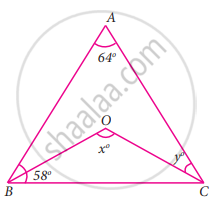Advertisements
Advertisements
Question
In Fig., below, ABCD is a parallelogram in which ∠A = 60°. If the bisectors of ∠A and ∠B meet at P, prove that AD = DP, PC = BC and DC = 2AD.

Solution

AP bisects `∠`A
Then, `∠`AP = `∠`PAB = 30°
Adjacent angles are supplementary
Then,`∠`A + `∠`B =180°
`∠`B + 60° =180° ÐA = 60°
`∠`B = 180° - 60°
`∠`B = 120°
BP bisects `∠`B
Then, `∠`PBA `∠`PBC = 30°
`∠`PAB = `∠`APD = 30° [Alternative interior angles]
∴AD = DP [ ∵ Sides opposite to equal angles are in equal length]
Similarly
`∠`BA = `∠`BPC = 60° [Alternative interior angle]
∴ PC = BC
DC = DP + PC
DC = AD + BC [ ∵ DP = AD, PC = BC ]
DC = 2AD [ ∵ AD = BC Opposite sides of a parallelogram are equal].
APPEARS IN
RELATED QUESTIONS
ABCD is a square. AC and BD intersect at O. State the measure of ∠AOB.
The sides AB and CD of a parallelogram ABCD are bisected at E and F. Prove that EBFD is a parallelogram.
P and Q are the points of trisection of the diagonal BD of a parallelogram AB Prove that CQ is parallel to AP. Prove also that AC bisects PQ.
In a parallelogram ABCD, write the sum of angles A and B.
In a parallelogram ABCD, if ∠D = 115°, then write the measure of ∠A.
In a parallelogram ABCD, if ∠A = (3x − 20)°, ∠B = (y + 15)°, ∠C = (x + 40)°, then find the values of xand y.
PQRS is a quadrilateral, PR and QS intersect each other at O. In which of the following case, PQRS is a parallelogram?
∠P = 100°, ∠Q = 80°, ∠R = 95°
The figure formed by joining the mid-points of the adjacent sides of a rhombus is a
P is the mid-point of side BC of a parallelogram ABCD such that ∠BAP = ∠DAP. If AD = 10 cm, then CD =
In the given figure, ∠A = 64°, ∠ABC = 58°. If BO and CO are the bisectors of ∠ABC and ∠ACB respectively of ΔABC, find x° and y°
